
Guests
- Thomas DrakeNational Security Agency whistleblower. He’s the winner of the 2011 Ridenhour Prize for Truth-Telling and co-recipient of the Sam Adams Associates for Integrity in Intelligence award.
- Jesselyn Radacka former ethics adviser to the United States Department of Justice. She is currently the director of National Security & Human Rights at the Government Accountability Project, the nation’s leading whistleblower organization. Her new book is called TRAITOR: The Whistleblower and the “American Taliban”.
We speak with Thomas Drake, who was targeted after challenging waste, mismanagement and possible constitutional violations at the National Security Agency, but the case against him later collapsed. Drake was one of several sources for a Baltimore Sun article about a $1.2 billion NSA experimental program called “Trailblazer” to sift through electronic communications for national security threats. “My first day on the job was 9/11. And it was shortly after 9/11 that I was exposed to the Pandora’s box of illegality and government wrongdoing on a very significant scale,” Drake says. He alleged that the program was inefficient compared to a rival program called “ThinThread” and also violated Americans’ privacy rights. As a result, he faced 35 years in prison for charges under the Espionage Act, but was not ever actually accused of spying. Instead, he was accused of holding on to classified documents in his basement that he says he did not even know were classified.
In a major embarrassment for the Department of Justice, his case ended last year in a misdemeanor plea deal. Now the former top spokesman for the Justice Department, Matthew Miller, seems to be reversing his stance on the prosecution of Drake, saying the case may have been an “ill-considered choice for prosecution.”
All of this comes amidst the Obama administration’s unprecedented attack on whisteblowers. “It’s a way to create terrible precedent to go after journalists and a backdoor way to create an Official Secrets Act, which we have managed to live without in this country for more than 200 years. And I think it’s being done on the backs of whistleblowers,” says Drake’s attorney, Jesselyn Radack, a former ethics adviser to the Justice Department. She is currently the director of National Security & Human Rights at the Government Accountability Project, the nation’s leading whistleblower organization. Her new book is called ”TRAITOR: The Whistleblower and the 'American Taliban.'” [includes rush transcript]
Transcript
AMY GOODMAN: We turn now to whistleblowers and the unprecedented attack they’ve come under during the Obama administration. Evoking the Espionage Act of 1917, the administration has pressed criminal charges against no fewer than six government employees, more than all previous presidential administrations combined. Their crime? Leaking classified information to reporters.
Last month, Jake Tapper, the White House correspondent for ABC News, questioned the Obama administration for applauding truth seekers abroad while simultaneously prosecuting them at home. Tapper raised his concerns shortly after White House Press Secretary Jay Carney lamented the deaths of journalists Anthony Shadid and Marie Colvin, saying they had given their lives “in order to bring truth” while reporting in Syria. This is reporter Jake Tapper.
JAKE TAPPER: How does that square with the fact that this administration has been so aggressively trying to stop aggressive journalism in the United States by using the Espionage Act to take whistleblowers to court? You’re currently—I think that you’ve invoked it the sixth time. And before the Obama administration, it had only been used three times in history. This is the sixth time. You’re suing a CIA officer for allegedly providing information in 2009 about CIA torture. Certainly that’s something that’s in the public interest of the United States. This administration is taking this person to court. There just seems to be a disconnect here: you want aggressive journalism abroad; you just don’t want it in the United States.
PRESS SECRETARY JAY CARNEY: Well, I would hesitate to speak to any particular case, for obvious reasons, and I would refer you to the Department of Justice for more on that.
NERMEEN SHAIKH: That was Jay Carney. Now, a former top spokesman for the Justice Department, Matthew Miller, seems to be reversing his stance on the prosecution of National Security Agency whistleblower Thomas Drake. Drake was initially charged under the Espionage Act for leaking information about waste mismanagement at the agency, but the case against him later collapsed.
In a recent exchange with Politico correspondent Josh Gerstein, Miller said the Drake case was legitimate, unlike some others. He wrote, quote, “Drake did seem to be trying to expose actual government waste. I think the outcome of the case probably shows that it was an ill-considered choice for prosecution.”
Miller had previously defended the prosecution of Thomas Drake. He was quoted in the New York Times as saying, quote, “It’s an important principle that people who have access to classified information follow the law and the agreements they have signed to protect that information.” Miller also said, “The indictment was brought on the merits, and nothing else.”
As recently as this month, Miller had mounted one of the first public defenses of the Obama administration’s unprecedented prosecution of alleged leakers. His piece in The Daily Beast is called “Obama Is Right to Prosecute Leakers Who Are Not the Same as Whistle-Blowers.” In the piece, Miller claims, quote, “Leaks of classified information can endanger American soldiers and intelligence officers and expose sensitive national-security programs to our enemies. Whistle-blowers expose violations of law, abuse of authority, or a substantial and specific threat to public health or safety.”
AMY GOODMAN: Those, the words of the former top spokesman for the Justice Department, Matthew Miller.
Well, for more, we’re joined by Thomas Drake himself. He’s here in New York City for the Brennan Center and the Government Accountability Project discussion on national security whistleblowers. Drake is the winner of the 2011 Ridenhour Prize for Truth-Telling and co-recipient of the Sam Adams Associates for Integrity in Intelligence award.
And we’re continuing with Jim Bamford in London, who was hired by the Drake defense team as an expert witness in his case.
In addition, we’re joined by Thomas Drake’s attorney, Jesselyn Radack, a former ethics adviser to the U.S. Department of Justice. Also a whistleblower, she is currently the director of National Security & Human Rights at the Government Accountability Project, the nation’s leading whistleblower organization, and she has a book out, which is called TRAITOR: The Whistleblower and the “American Taliban”.
Thomas Drake, Jesselyn Radack and Jim Bamford again, thanks so much, all, for joining us. Thomas Drake, talk about what happened in your case. What did you do? What were you charged with? And how are you sitting here today?
THOMAS DRAKE: Well, I sit here as a free man. I was charged under the Espionage Act as part of an indictment that was handed down on me in April of 2010. There was five counts under the Espionage Act for retaining—not leaking, retaining—national defense information, although the government alleged that I was doing so for the purpose of disclosure to those unauthorized to receive it. I was also charged with obstruction of justice, as well as making false statements to FBI agents.
AMY GOODMAN: Talk about what it was—what kind of information you are charged with keeping and why you are called a whistleblower. What information did you want to get out? What did—what were the problems you saw at the NSA? How long did you work there?
THOMAS DRAKE: At the NSA, I worked there for almost seven years. Yeah, I was actually hired in from the outside. It was a special program that General Hayden had sponsored. There was a lot of pressure from stakeholders, particularly in Congress. The NSA was too insular. It was hiring from within, you know, promoting from within. They needed to bring in fresh blood, stir up the gene pool, as it were. And so, I was—about a dozen of us were hired in from the outside during a six—about a six-month period in 2001 prior to 9/11.
AMY GOODMAN: What did you find?
THOMAS DRAKE: Well, my first day on the job was 9/11. And it was shortly after 9/11 that I was exposed to the Pandora’s box of illegality and government wrongdoing on a very significant scale. So, you had the twin fraud, waste—you know, the twin specters of fraud, waste and abuse being committed on a vast scale through a program called Trailblazer, a multi-billion-dollar program, when in fact there was alternatives that already existed and fulfilled most all the requirements of Trailblazer, even prior to 9/11.
AMY GOODMAN: What did Trailblazer do?
THOMAS DRAKE: Trailblazer was ostensibly the flagship program that Hayden said, “We’re going to go out to American industry and buy it. We’re not going to make it. We’re not going to take the best of American ingenuity and innovation. We’re just simply going to go to the defense contractors and let them figure out how to meet the demands of the digital age.” The digital age was a significant challenge for NSA. It was having great difficulty not only making sense of the vast streams of data that were pouring in from all over, but also figuring out what was going on. Essentially, what was happening is NSA was going blind, it was going deaf.
NERMEEN SHAIKH: Can you talk about the other program, ThinThread, and how it related to what Trailblazer did, and why the NSA chose Trailblazer, in fact, instead of ThinThread?
THOMAS DRAKE: Well, a lot of money is involved. I mean, NSA—you talk about, you know, the corporate and the military-industrial complex. You start—we’re talking about, you know, upwards of a $4 billion program. ThinThread actually was a Skunk Works program. It was actually a very small—
NERMEEN SHAIKH: What does that mean?
THOMAS DRAKE: —a very small group of individuals who, during the '90s, said, “You know what? We're going to figure out how to deal with the digital age. We’re going to figure out how to make sense of large streams of data. We’re going to figure out how to maintain the fidelity and integrity of what it is that we collect. And we’re going to make sense out of it at the same time.” And they actually solved the heart of that problem. It was a challenged problem for NSA. They solved the heart of it. It was only a several-million-dollars solution, prior to 9/11, and it was ready for operational deployment prior to 9/11. It was rejected by NSA.
The critical thing that I discovered was not just the massive fraud, waste and abuse, but also the fact that NSA had chosen to ignore a 23-year legal regime, which had been established in 1978, called the Foreign Intelligence Surveillance Act, with a Foreign Intelligence Surveillance Court, and which, at NSA, during the time that I was not only at NSA but also in the military flying on RC-135s overseas during the latter part of the Cold War, it was a contract, the one thing you did not do. It was the prime directive of NSA. It was the—the—First Amendment at NSA, which is, you do not spy on Americans—
AMY GOODMAN: And what did you find?
THOMAS DRAKE: —without a warrant. I found, much to my horror, that they had tossed out that legal regime, that it was the excuse of 9/11, which I was told was: exigent conditions now prevailed, we essentially can do anything. We opened up Pandora’s box. We’re going to turn the United States of America into the equivalent of a foreign nation for the purpose of a—of dragnet, blanket electronic surveillance.
NERMEEN SHAIKH: So, in other words, now warrantless wiretapping of U.S. citizens by the NSA and other intelligence agencies is legal?
THOMAS DRAKE: Well, there was a series of legislation that Jesselyn Radack can—probably best to address the legality of this. But later on, once the fact of warrantless wiretapping came out in the press in the James Risen-Eric Lichtblau article in December of 2005, which launched a major DOJ national security investigation, which I ultimately got caught up—yes, during that whole period, we’re talking a very, very super secret program, which is actually referenced—that program is referenced in James Bamford’s blockbuster article in—is the lead article in Wired Magazine for the month of April. That particular program was—in fact violated, on a vast scale, the Fourth Amendment rights of U.S. citizens.
AMY GOODMAN: Jesselyn—
THOMAS DRAKE: It didn’t matter. It was just used as an excuse, that the fair game that NSA had, the legitimate ability of NSA to collect foreign intelligence from overseas, well, now that capability is being used to collect against U.S. citizens and everybody else in the United States of America.
AMY GOODMAN: And Thomas Drake, when you raised this to your higher-ups, your supervisors, your superiors at the NSA, what did they say?
THOMAS DRAKE: Well, I went specifically to Maureen Baginski with my concerns.
AMY GOODMAN: Who is?
THOMAS DRAKE: She, at the time, was the signals intelligence director, the number three person at NSA. And she had rejected the ThinThread solution out of hand, said they had gone with a different solution, they didn’t need it anymore. And I kept pressing her hard. I said, “We’re violating the law. We cannot do this.” And she said, “If you have a problem with it, take it up with the Office of General Counsel.” I was specifically told by the Office of General Counsel and one of the attorneys, senior attorneys there, named Vito Potenza, that it had all been approved by the White House, NSA was the executive agent, and it was all legal. And I knew in that moment I can no longer remain complicit, and I could not serve as an accomplice, into the subversion of our own Constitution.
AMY GOODMAN: So what did you do?
THOMAS DRAKE: I started blowing the whistle within, and I started blowing the whistle with two 9/11 congressional investigations, as well as a multi-year Department of Defense inspector general audit investigation, in which I, as a whistleblower, was an unnamed senior official, along with Diane Roark, Ed Loomis, Kirk Wiebe and Bill Binney.
AMY GOODMAN: And what happened?
THOMAS DRAKE: They launched a formal audit investigation regarding the requirements of ThinThread and Trailblazer. And—
AMY GOODMAN: And they also launched an investigation of you.
THOMAS DRAKE: Well, that investigation actually, interestingly enough, was a result of a Department of Justice criminal national security investigation to find the, quote-unquote, “sources” for the New York Times article written by Lichtblau and Risen. And that’s ultimately how I was caught up. During—prior to my indictment, they were convinced that I had something to do with that article, and in fact, I didn’t. And so, I had—did have contact with a reporter from the Baltimore Sun, in which I actually gave unclassified information regarding the fact that there was a legal alternative to the secret program that had been approved by the White House in concert between Hayden and Cheney, a piece of paper, a memo that was written by John Yoo, held by David Addington in a safe in the White House. And so, I ended up—you know, I ended up also talking to that reporter about the significant fraud, waste and abuse, OK, beyond just Trailblazer, because she had written a series of articles, but also the fact that there was this legal alternative, which would not only have provided superior intelligence to the United States of America, but also would have done so completely honoring the Fourth Amendment and fully compliant with FISA.
AMY GOODMAN: Jesselyn Radack, you represent Thomas Drake, and you’re a whistleblower yourself within the Justice Department. We only have a minute, but we’re going to continue this conversation online at democracynow.org. Talk about the significance of Thomas Drake’s case and ultimately what ended up being the charge.
JESSELYN RADACK: Ultimately, all 10 felony counts were dropped, and he ended up pleading guilty to a minor misdemeanor for exceeding the authorized use of a government computer, which is like using Facebook too much while you’re at work. The significance is that he was the fourth person in U.S. history to be charged under the Espionage Act. The first, tellingly, was Daniel Ellsberg. And now there are six people. The most recent to be charged is John Kiriakou. And all of these people are not spies. They’re whistleblowers. And they are being—they’re the people who revealed torture and warrantless wiretapping, some of the biggest scandals that occurred in my generation.
NERMEEN SHAIKH: How do explain the unprecedented prosecution of whistleblowers and leakers under the Obama administration?
JESSELYN RADACK: Really, I think it’s a way to create terrible precedent to go after journalists and a backdoor way to create an Official Secrets Act, which we have managed to live without in this country for more than 200 years. And I think it’s being done on the backs of whistleblowers. And it’s also meant to send a very chilling message to government employees not to speak out about fraud, waste, abuse and patent illegality.
AMY GOODMAN: We’re going to leave it there, but we’re going to continue this conversation. Part two will appear soon online today at democracynow.org. Our guests have been Jesselyn Radack, director of National Security & Human Rights at the Government Accountability Project. Her new book is called TRAITOR: The Whistleblower and the “American Taliban”. And we’ve been joined by Thomas Drake here on Democracy Now!, NSA whistleblower. And thanks also to James Bamford.


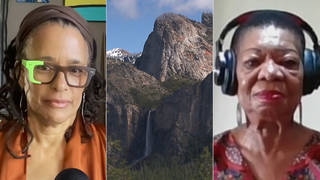
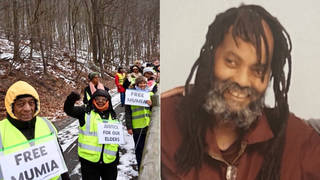
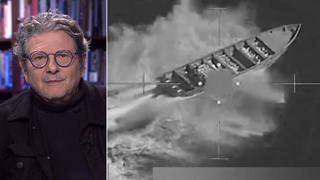





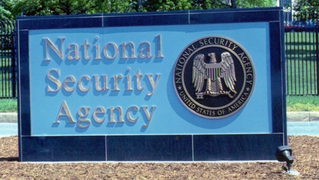

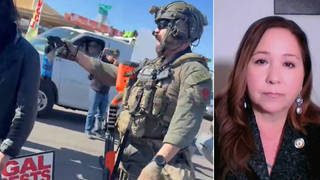
Media Options